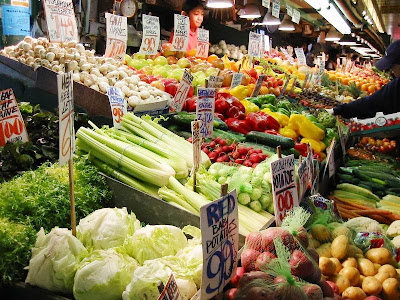Let this be another reminder of why eating more veggies is good for you: Happiness! Guest blogger Virginia Cunningham explains below.
Some Take Homes:
 You’ve been told that eating lots of fresh fruits and vegetables is good for you about a million times. You’ve likely heard it on TV, read it in newspapers and magazines, and likely grew up hearing it from your parents and family too.
You’ve been told that eating lots of fresh fruits and vegetables is good for you about a million times. You’ve likely heard it on TV, read it in newspapers and magazines, and likely grew up hearing it from your parents and family too.
Some Take Homes:
- There seems to be a correlation with eating more veggies and greater mental health.
- A British study that looked at data from 80,000 people suggests that 7 or more servings of vegetables and fruits per day is needed for optimal mental well-being.
- It's not an all or nothing phenomenon, increasing your fruit and vegetable intake by any amount should make a difference.
On a similar note, Dr. Greger has some fascinating posts on interesting mechanistic research explaining why certain vegetables ease depression and why chicken, eggs and other animals products can worsen it.
Eat Your Veggies For Happiness!
 You’ve been told that eating lots of fresh fruits and vegetables is good for you about a million times. You’ve likely heard it on TV, read it in newspapers and magazines, and likely grew up hearing it from your parents and family too.
You’ve been told that eating lots of fresh fruits and vegetables is good for you about a million times. You’ve likely heard it on TV, read it in newspapers and magazines, and likely grew up hearing it from your parents and family too.
That’s why most of us equate eating fresh fruits and vegetables with a healthy diet and a healthy body; however, it turns out that eating your vegetables and snacking on fruit could actually make you happier in your daily life.
The Link Between Physical Health and Depression
Most people think they should eat their fruits and vegetables to preserve their physical health. Of course, this is absolutely true. Fresh fruits and vegetables are full of nutrients, vitamins and minerals that your body needs, and they’re generally very low in calories, while being free of harmful fats.
However, there’s also a major link between physical health and depression. In many cases, adults that suffer from depression may have a higher incidence of heart disease and other types of cancer.
It seems the opposite is also true – that what you eat and how it affects your physical health can also alter your mood and general disposition. In this way, physical health and depression are very much linked, and what you eat appears to be linked to how you feel – both mentally and physically.
Food May Affect Brain Chemistry
Research has elucidated that depression is caused in part by temporary or permanent chemical imbalances in the brain.
The more researchers study food and how it affects our brains, the more they’re starting to understand that what people contribute to their biochemical and metabolic processes control how our brain’s produce necessary neurochemicals, like serotonin. Some of these chemicals may be linked to both depression and general feelings of wellbeing.
How Much Should I Eat?
According to a 2012 British study, which looked at data from 80,000 people, the more fruit and vegetables people ate, the better their reported moods and mental health. And the best moods and mental health were found in those who ate about seven or more servings per day. While that might sound like a lot, it really isn’t when you break it down.
Having a piece of fruit as part of a healthy breakfast, and a lunch salad or main course with an additional two servings of fruits and vegetables accounts for about half of those seven servings. A healthy fruit or vegetable as a snack and an additional two servings of vegetables for dinner can easily make up those seven servings per day.
It might take some getting used to on your part, especially if you’re used to reaching for the cookie jar when you want a snack, or relying on dessert to finish your dinner; however, the physical health and emotional benefits of eating more fruits and vegetables appears to be well worth the effort.
About the author:
Virginia Cunningham is a health and beauty writer who works with Bellezza Spa, a Miami salon, to help others maintain a healthier and happier lifestyle. As a yoga enthusiast and mother of three, she always makes sure that her family stays healthy, both emotionally and physically. With daily yoga and a well-balanced diet, she is able to maintain a healthy lifestyle.



